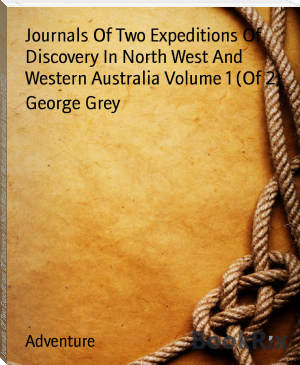Journals Of Two Expeditions Of Discovery In North West And Western Australia Volume 1 (Of 2), George Grey [robert munsch read aloud txt] 📗

- Author: George Grey
Book online «Journals Of Two Expeditions Of Discovery In North West And Western Australia Volume 1 (Of 2), George Grey [robert munsch read aloud txt] 📗». Author George Grey
Conceived At The Time That He Had Made Some Mistake, And Paid No
Attention To Him Until I Afterwards Twice Saw The Same Traces Myself.
Birds.
To Describe The Birds Common To These Parts Requires More Time Than To
Detail The Names Of The Few Quadrupeds To Be Found; Indeed In No Other
Country That I Have Yet Visited Do Birds So Abound. Even The Virgin
Forests Of South America Cannot, In My Belief, Boast Of Such Numerous
Feathered Denizens; Yet I Cannot, After All, Assert That The Number Of
Genera And Species Is At All Proportionate To That Of Individual Birds.
The Contrary Is Probably The Real Case.
Beauty Of The Birds.
The Birds Of This Country Possess In Many Instances An Excessively
Beautiful Plumage; And He Alone Who Has Traversed These Wild And Romantic
Regions, Who Has Beheld A Flock Of Many-Coloured Parakeets Sweeping Like
A Moving Rainbow Through The Air Whilst The Rocks And Dells Resounded
With Their Playful Cries, Can Form Any Adequate Idea Of The Scenes That
There Burst On The Eyes Of The Wondering Naturalist.
The Beginning Of The Month Of February, Or The End Of January, Is The
Season In Which The Birds In These Parts Pair. In The Beginning Of March
I Found Many Nests With Eggs In Them; And In The End Of That Month Eggs
Nearly Hatched Were Observed In Most Of The Nests, As Well As Young Birds
Occasionally.
Rapacious Birds.
Of Rapacious Birds I Saw But Four Kinds, But These Are By No Means
Common:
The First Species Was A Very Large Bird, Of A Dark Colour (Aquila Fucosa,
Cuvier) In Size, Appearance, And Flight Closely Resembling The Golden
Eagle Which I Have Often Seen, And Have Once Shot On The North-West Coast
Of Ireland. I Have Approached These Birds Closely--So Closely Indeed That
I Have On Two Occasions Shot Them, But Each Time They Fell Into A Thick
Mangrove Inlet And I Was Not Fortunate Enough To Procure Either Of Them;
They Appeared To Me Always To Frequent The Shores, For I Never Saw Them
Further Inland Than A Mile From The Sea. The Large Nests Captain King
Mentions As Having Been Found Upon The Coast I Imagine Must Have Belonged
To This Species.
The Second Species Was A Sort Of Hawk (Haliaeetus Leucosternus, Gould)
Rather Larger Than The Sparrow-Hawk, Of A Light Cinnamon Colour, With A
Perfectly White Head. They Also Frequent The Shores, But I Never Shot
One.
The Third Species Was A Peregrine Falcon (Falco Melanogenys, Gould) Which
Volume 1 Chapter 11 (Natural History Climate Aborigines) Pg 150Is Nearly Allied To That Of Europe. I Was Not Fortunate Enough To Procure
A Specimen Of This Bird.
The Fourth Was The Athene Boobook. Belly Brown And White; Wings Brown,
With White Spots; Third Quill-Feather, Longest; Legs Feathered, Lightish
Brown Colour; Tail Brownish White, Marked With Transverse Bars Of A
Darker Brown; Eye Prominent; Iris Blue. The Only Difference I Could
Observe Between The Male And Female Is That The Female Is Rather Larger
Than The Male, And Her Colours Somewhat Lighter. These Birds Inhabit The
Whole Of That Part Of North-Western Australia Lying Between The Prince
Regent And Glenelg Rivers, And Probably May Be Distributed Over The
Greater Portion Of The Continent. They Feed On Insects, Reptiles, And
Birds Of The Smaller Kind. I Have Always Found Them Seated In Holes In
The Rocks, Or In Shady Dells, And Have Never Seen Them Fly In The Daytime
Unless Compelled By Fear; They Are Very Stupid When Disturbed, And In
Flight And Manner Closely Resemble The Common English Owl. I Cannot
However Recollect Having Ever Seen One On The Wing During The Night.
Upon Describing The Two Singular Birds Mentioned Above In Chapter 9 To
Mr. Gould He Informed Me That They Were Most Probably Of The Rare Species
Anas Semipalmata.
Remarkable Nest.
I Have Already Spoken In The 9th Chapter Of A Very Curious Sort Of Nest
Which Was Frequently Found By Myself And Other Individuals Of The Party,
Not Only Along The Seashore, But In Some Instances At A Distance Of Six
Or Seven Miles From It. This Nest, Which Is Figured In Illustration 19, I
Once Conceived Must Have Belonged To The Kangaroo Rat I Have Above
Mentioned, Until Mr. Gould, Who Has Lately Returned From Australia,
Informed Me That It Is The Run Or Playing Ground Of The Bird He Has Named
Chalmydera Nuchalis.
These Nests Were Formed Of Dead Grass, And Parts Of Bushes, Sunk A Slight
Depth Into Two Parallel Furrows, In Sandy Soil, And Then Nicely Arched
Above. But The Most Remarkable Fact Connected With Them Was That They
Were Always Full Of Broken Shells, Large Heaps Of Which Protruded From
Each Extremity Of The Nest. These Were Invariably Seashells. In One
Instance, In The Nest Most Remote From The Sea That We Discovered, One Of
The Men Of The Party Found And Brought To Me The Stone Of Some Fruit
Which Had Evidently Been Rolled In The Sea; These Stones He Found Lying
In A Heap In The Nest, And They Are Now In My Possession.
Emus.
I Have Seen No Emus In North-Western Australia, But On Two Occasions
Their Tracks Were Impressed In The Mud On Some Plains Lying On The Banks
Of Glenelg River; And Mr. Dring, Of H.M.S. Beagle, Informed Me That,
Whilst That Vessel Was Employed In The Survey Of Fitzroy River, About
Volume 1 Chapter 11 (Natural History Climate Aborigines) Pg 151Seventy Miles To The Southward Of The Former, He Not Only Several Times
Saw Traces Of Them But That, On One Occasion When He Was In The Bush, Two
Of Them Passed Within A Few Yards Of Him. They May, I Conceive, Therefore
Be Considered As Inhabitants Of This Part Of The Continent.
Alligators.
No Alligators Were Seen By The Land Party In Any Of The Rivers Of
North-Western Australia, But The Crew Of The Schooner Saw One In Hanover
Bay. I Can However Safely Assert From My Own Experience That They Are By
No Means Numerous Upon This Coast. At The Islands Of Timor And Roti
However They Abound.
Turtles.
Turtles Were Abundant On The Coast, And A Freshwater Tortoise Was Found
Inland.
Plants.
Amongst The Vegetable Kingdom I Shall Only Observe Generally That The
Calamus, Or Rattan, Which In King's Voyage* Is Considered To Be Peculiar
To The Primary Granitic Formation On The East Coast, Is Abundant In The
Interior Of The North-West Between Latitude 15 And 17 Degrees South.
I Found A Dwarf Cabbage-Palm Between 15 And 16 Degrees South Latitude,
Always In Moist Situations In The Neighbourhood Of Streams, Although Not
Immediately On The Banks.
Of The Family Of Urticeae Many Species Of Ficus Were Observed.
The Banksia, Common To Swan River, And Bearing A Yellow Flower, Is To Be
Found In Many Of The Valleys On The North-West Coast; Thus Appearing To
Form An Exception To Mr. Cunningham's Observation Inserted In Captain
King's Voyage,* Wherein He Says:
Viewing The General Distribution Of Banksia, It Is A Singular Fact In The
Geographical Distribution Of This Genus That Its Species, Which Have Been
Traced Through Almost Every Meridian Of The South Coast, Upon The Islands
In Bass Strait, In Van Diemen's Land, And Widely Scattered Throughout The
Whole Extent Of New South Wales To The North Coast, At Which Extreme
Banksia Dentata Has Been Observed As Far West As Longitude 136 Degrees
South, Should Be Wholly Wanting On The Line Of The North-West Coast.
Volume 1 Chapter 11 (Footnote) Pg 152
(*Footnote. Appendix, Volume 2.)
Volume 1 Chapter 11 (Footnote) Pg 153(*Footnote. Ibid.)
Volume 1 Chapter 11 (Natural History Climate Aborigines) Pg 154I Observed A Great Variety Of Plants Of The Order Leguminosae.
Of The Extraordinary Capparis Resembling The African Adansonia I Have
Already Spoken In Chapter 6.
A Species Of Callitris (Pine) Was Common, As Was The Pandanus; And The
Araucaria Excelsa Was Found On The Heights, Both Near The Sea Coast And
Further Inland.
Climate. Its Healthiness.
I Conceive The Climate Of North-Western Australia To Be One Of The Finest
In The World, And My Reasons For Thus Thinking Are Grounded Upon The
Following Circumstances.
Proofs Of Its Salubrity.
I Was Resident There From The Beginning Of The Month Of December 1837 To
The Middle Of The Month Of April 1838; A Period Of Four Months And A
Half: And During The Whole Of This Time The Men Under My Command Were
Exposed To Great Hardships And Privations. On One Occasion Three Of Us
Slept In The Open Air Without Any Covering Or Warm Clothes For Five
Successive Nights, During Three Of Which We Had Constant Showers Of Heavy
Rain, And Yet Did Not In





Comments (0)